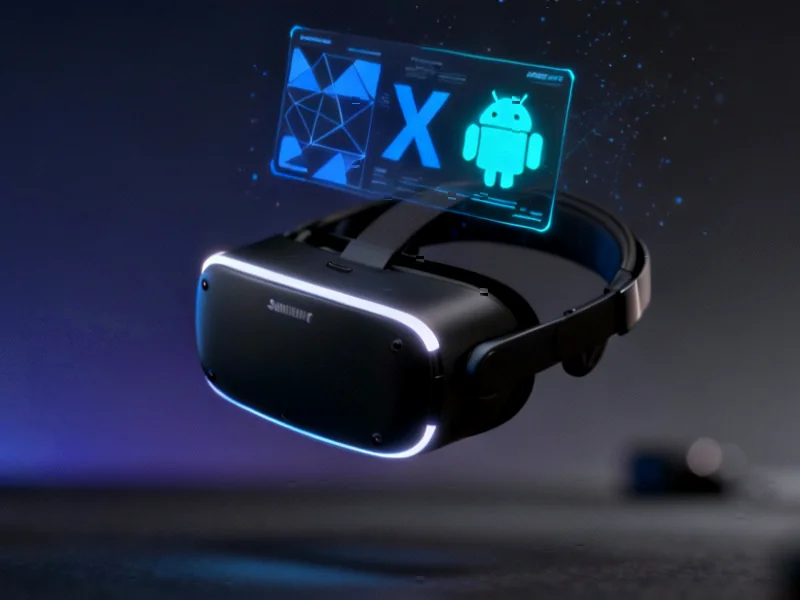Samsung and Google Forge New Path in Mixed Reality
In a strategic move that reshapes the mixed reality landscape, Samsung and Google have launched the Galaxy XR headset at $1,799—positioning it as a formidable competitor to Apple’s Vision Pro while undercutting the latter’s price by approximately $1,700. This collaboration marks a significant milestone in bringing Android’s extensive app ecosystem into the spatial computing arena through Google’s newly introduced Android XR platform., according to industry developments
Table of Contents
Price Strategy and Market Positioning
With the Galaxy XR priced nearly 50% lower than Apple’s Vision Pro, Samsung is clearly targeting a broader audience that may have been hesitant to invest in high-end mixed reality technology. This aggressive pricing strategy comes at a crucial time when many early Vision Pro adopters reported, our earlier report, buyer’s remorse, primarily due to the device’s $3,500 price point and limited application library. Apple’s subsequent production halt due to low demand further highlights the challenges of premium pricing in the emerging mixed reality market.
Technical Specifications and Performance
The Galaxy XR is powered by Qualcomm’s Snapdragon XR2+ Gen 2 processor, coupled with 16GB of RAM and 256GB of internal storage. Its display system features Micro-OLED technology delivering 3,552 × 3,840 pixels per eye at refresh rates up to 90Hz. While battery life matches the Vision Pro’s 2.5 hours for general use, the Galaxy XR achieves a significant weight advantage—potentially up to 200 grams lighter depending on configuration, addressing one of the common comfort concerns with extended mixed reality usage.
Android XR Ecosystem and Software Integration
Google’s Android XR platform represents the company‘s most comprehensive effort to date in spatial computing. The system seamlessly integrates with the Google Play Store, bringing Android’s vast application library into mixed reality. Notably, the platform includes a dedicated mixed reality YouTube portal—a notable omission from Apple’s visionOS despite YouTube being owned by Google. The headset also supports Windows PC connectivity for app mirroring and full keyboard and mouse input, mirroring Apple’s Mac integration feature while expanding compatibility to the larger Windows user base.
AI as a Differentiating Factor
Perhaps the most significant distinction between the two platforms lies in their approach to artificial intelligence. While Apple has only recently begun integrating Apple Intelligence into its ecosystem, Google’s Gemini assistant is deeply embedded throughout the Android XR experience. The AI capabilities extend beyond simple voice commands to include contextual understanding and visual recognition. Users can perform reverse image searches by simply circling objects using hand-tracking controls, while an immersive Google Maps integration provides landmark information and trip planning capabilities within mixed reality environments., according to market analysis
Input Options and Accessories
Samsung offers greater flexibility in input methods compared to Apple’s visionOS. In addition to sophisticated hand-tracking controls, the Galaxy XR supports traditional game controllers starting at $174.99—catering to gamers and users who prefer physical input devices for certain applications. This multi-modal approach to interaction demonstrates Samsung’s understanding that different use cases may benefit from different control schemes., according to recent developments
The Road Ahead for Mixed Reality
While Samsung’s entry presents a strong challenge to Apple’s vision, the mixed reality market remains in its early stages. Apple hasn’t abandoned its spatial computing ambitions and is reportedly developing a lighter, more affordable Vision Pro variant, though the company may prioritize smart glasses first in response to competitors like Meta. The success of the Galaxy XR will ultimately depend on whether Samsung and Google can cultivate a robust software ecosystem that demonstrates clear value beyond the initial novelty of mixed reality experiences.
The battle between these tech giants represents more than just a price war—it’s a fundamental disagreement about how mixed reality should evolve and who should lead that evolution. With Samsung betting on accessibility and AI integration while Apple focuses on premium experiences, consumers stand to benefit from the accelerated innovation that such competition typically brings.
Related Articles You May Find Interesting
- Beyond Pixels: How Metapixel Technology is Redefining Visual Realism in Micro-Di
- Breakthrough Solar Catalyst Converts CO2 to Ethanol with Unprecedented Efficienc
- Molecular Weaving Breakthrough Enables Energy-Efficient Heavy Water Production
- Solar Power Set to Dominate Global Energy Mix by Century’s End, Reports Indicate
- AI-Driven Breakthrough in Cobalt Superalloy Design Delivers Enhanced High-Temper
References
This article aggregates information from publicly available sources. All trademarks and copyrights belong to their respective owners.
Note: Featured image is for illustrative purposes only and does not represent any specific product, service, or entity mentioned in this article.



